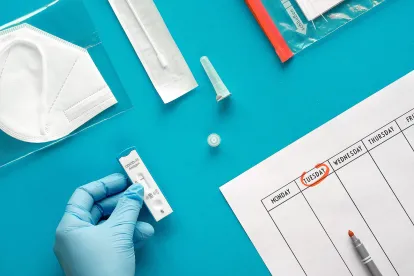On December 27, 2021, the Centers for Disease Control and Prevention (CDC) announced that “given what we currently know about COVID-19 and the Omicron variant, CDC is shortening the recommended time for isolation from 10 days for people with COVID-19 to 5 days, if asymptomatic, followed by 5 days of wearing a mask when around others.” The CDC explained that the shortened isolation time requirements are based on the fact that the majority of COVID-19 transmission typically occurs in the first one-to-two days of sickness, before the individual even exhibits symptoms and then for two-to-three days after.
Similarly, the CDC shortened the quarantine period for individuals exposed to COVID-19 but who have yet to test positive. The recommended quarantine period for individuals who have been exposed depends on whether the individual is symptomatic and whether they are fully vaccinated and boosted.
-
Unvaccinated individuals and individuals whose vaccines were not administered recently (six months for the Pfizer and Moderna vaccines, and two months for the Johnson & Johnson vaccine) and who have not received a booster shot should quarantine for five days, followed by an additional five days of wearing a mask.
-
Fully vaccinated individuals, including those who have received a booster shot, do not need to quarantine after exposure if asymptomatic but should wear a mask for 10 days following exposure.
-
Note that just over 60% of the U.S. population is fully vaccinated, but only about 30% of adults who are fully vaccinated have received a booster shot.
Exposed individuals should take a COVID-19 antigen test on the fifth day following exposure. Further, if an individual experiences symptoms associated with COVID-19, the individual should “quarantine until a negative test confirms symptoms are not attributable to COVID-19.”
What is the quarantine requirement for individuals with COVID-19 who are experiencing symptoms?
-
If the symptoms include a fever, the CDC recommends the individual continue to stay home until the fever resolves, regardless of how much time has passed since receiving the positive COVID-19 test and regardless of vaccination status.
When can employers implement the new recommendations?
-
Employers can begin implementing the new recommendations immediately but should consider the following issues before doing so.
What should employers consider in implementing the new recommendations?
-
Impact of shortened isolation period. Although COVID-19 cases are expected to rise sharply following the holidays, the shortened isolation period will allow employees to return to work much faster than under the previous standards. This should minimize disruptions in business due to staffing shortages but may leave employees feeling uneasy.
-
Consider whether to update your policies. Although the CDC recommends a shortened quarantine period following a positive COVID-19 test or exposure to the virus, employers are not required to adopt the new recommendations. Businesses should evaluate whether the benefit of a faster return to work is outweighed by possible employee concerns regarding the risk of increased transmission. Further, businesses should make sure they are still complying with OSHA regulations and state or local rules that may be more restrictive than the CDC timeline.
-
Communicate changes to employees. If you decide that adopting the shortened quarantine timeline is right for your business, make sure to document clearly any changes to your company’s policy and communicate the same to employees via email or letter.
-
Educate employees and ease concerns. Some employees may feel uncomfortable with the reduced quarantine timeline. Assign a designated HR representative to which employees can direct concerns. Further, consider providing the HR representative with educational materials regarding the CDC’s underlying reasoning for reducing the quarantine timeline and the Omicron variant, and distribute the materials to employees who voice concerns.
-
Continue to assess requests for accommodation. The shortened quarantine timeline may spark an increase in employee requests for accommodations. Be prepared to discuss and offer accommodations where an employee has a medical condition that makes them particularly vulnerable to COVID-19 and asserts they do not feel comfortable reporting to work if the company adopts the shortened quarantine timeline. Businesses should follow their normal accommodation process, which may include requesting medical documentation from the employee and engaging in the interactive process to determine whether an accommodation is appropriate. However, even if the employee is not entitled to an accommodation under the ADA, express empathy and work with the employee to try to alleviate their fear.
Conclusion
The shortened quarantine and isolation recommendations, and what appears to be the decreased severity of the Omicron variant in comparison to earlier variants of the COVID-19 virus, are encouraging. However, businesses should continue to evaluate their COVID-19 response plans based on their individual business needs, state and local laws, and employee wellbeing. We recommend monitoring whether any state in which your business operates explicitly adopts or rejects the CDC shortened quarantine timeline.




 />i
/>i

